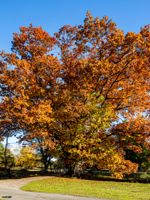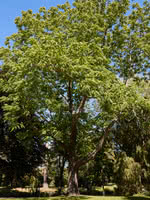Mon-Fri 9am - 5pm Mountain time
Northern Red Oak vs Black Walnut
Quercus rubra
Juglans nigra
NOT AVAILABLE THIS SEASON - MIGHT RETURN
Northern Red Oak is a medium-sized deciduous tree. It is fast-growing (for an oak tree) and is used primarily in lawns, parks, golf courses, street-side plantings, and commercial areas. Northern Red Oak's fall color is spectacular.
In open spaces, it has a short, massive trunk and an extensive crown. In forests Northern Red Oak grows with a tall columnar bole and small rounded head.
We are one of the only nurseries growing this tree.
Check out some video of the spectacular fall colour on our Northern Red Oak seedlings just before harvest on our YouTube Channel.
Note: Most Oak species can be considered toxic for many animals.
The Black Walnut is a slow growing, large, straight-stemmed tree with an open crown. It produces dense, very hard, edible nuts.
Black Walnut has a deeply-furrowed, black bark. Its leaves are about 1 foot long, composed of 15 - 23 slightly stalked leaflets on a moderately stout stock which provide good dappled shade.
Despite being highly valued for its edible nuts and its shade tree aesthetics, it is rare to see this tree on the prairies.
Note: Black Walnut's roots produce a substance named juglone that is toxic to some other plants. Consider this when choosing where you plant a black walnut, as you will not be able to grow tomato, potato, cabbage, eggplant, blueberry, azalea, rhododendron, lilac, red pine and apple in the surrounding area.
Note: Plant this tree once. It will not respond well to transplanting.
Note: Although self-pollinating, planting two trees significantly improves nut production.
A top CO2 absorbing species. Experts think this tree may help climate change more than others.

